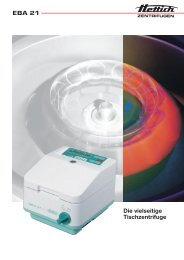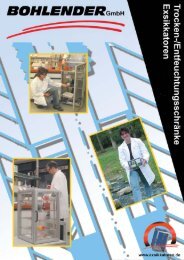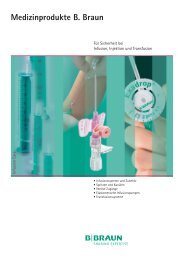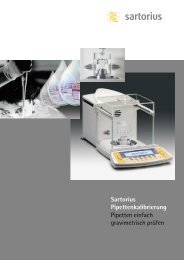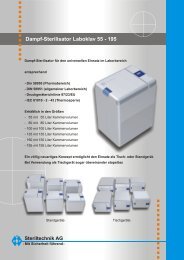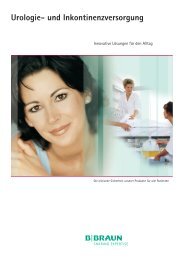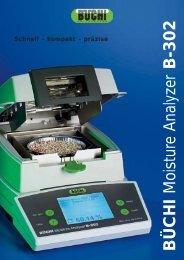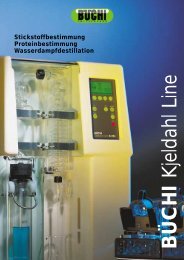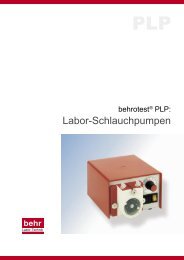NALGENE Centrifuge Tubes and Bottles
NALGENE Centrifuge Tubes and Bottles
NALGENE Centrifuge Tubes and Bottles
Create successful ePaper yourself
Turn your PDF publications into a flip-book with our unique Google optimized e-Paper software.
16<br />
16<br />
Use <strong>and</strong> Cleaning Guide<br />
Inspection<br />
Inspect centrifuge tubes <strong>and</strong> bottles carefully before each use. <strong>Centrifuge</strong><br />
ware is subjected to high g-forces while spinning, which can lead to<br />
failure. Safe laboratory practice requires that all centrifuge ware be<br />
inspected before each use. Plastic centrifuge ware is easy to inspect; it<br />
requires no special equipment. Initially, the effect of excessive stress in<br />
plastic can be seen as cloudiness <strong>and</strong> discoloration or as “crazing,” i.e.<br />
minute cracks visible when the tube is held at an angle in front of a<br />
bright light. With continued use, a crazed tube will develop larger cracks<br />
or will fail. <strong>Tubes</strong> should be discarded if cracks are readily visible to the<br />
unaided eye.<br />
Rotor Balancing<br />
Consult your centrifuge operator’s manual for instructions on rotor<br />
balancing <strong>and</strong> h<strong>and</strong>ling. Proper rotor h<strong>and</strong>ling, cleaning <strong>and</strong> balancing<br />
are extremely important. Because plastics have different densities, tubes<br />
<strong>and</strong> bottles of different styles or materials should not be arranged<br />
r<strong>and</strong>omly in the rotor.<br />
Tube <strong>and</strong> Bottle Selection<br />
<strong>NALGENE</strong> br<strong>and</strong> products make it easy for you to select the right centrifuge<br />
tube or bottle for your application. You’ll find just what you’ll need to<br />
make the right selection at www.nalgenunc.com. The site includes<br />
product information in the <strong>NALGENE</strong> on-line catalog, a comprehensive<br />
rotor matching, capacity <strong>and</strong> rotor speed recommendations, plus productspecific<br />
chemical resistance information.<br />
Recommended Guidelines<br />
• Be sure to check the tube or bottle chemical resistance to both sample<br />
<strong>and</strong> solvent.<br />
• Consider operating temperature when selecting a tube or bottle. The<br />
Low-High Speed Selector guide lists the maximum RCF at 4°C <strong>and</strong> 22°C.<br />
Use this information as a guideline.<br />
• Be aware: plastic tubes will undergo some degree of softening or<br />
hardening outside these ranges.<br />
• Additionally, temperature is not the only variable that causes deformation;<br />
centrifugal force, duration, type of rotor, fill volume <strong>and</strong> even tube<br />
angle all have an effect.<br />
Your safest policy is to pre-test all tubes or bottles under actual conditions,<br />
but using water rather than samples. Carefully follow the rotor<br />
manufacturer’s guidelines <strong>and</strong> product insert sheet information to ensure<br />
proper performance.<br />
Cleaning<br />
www.nalgenunc.com<br />
Disposable centrifuge ware should be discarded after one use. NOTE:<br />
When h<strong>and</strong>ling hazardous materials, decontaminate tubes prior to<br />
disposal. To clean reusable <strong>NALGENE</strong> centrifuge ware, we suggest the<br />
following procedure:<br />
• To loosen any residuals, presoak the tubes or bottles in <strong>NALGENE</strong> L900<br />
detergent. (See “General Cleaning” for specific recommendations.)<br />
Soak overnight to loosen stubborn residue.<br />
• Remove residue with a non-abrasive brush, or with a rubber or<br />
fluoropolymer policeman.<br />
• Wash <strong>and</strong> rinse product thoroughly, with distilled water as a final rinse.<br />
• Air dry.<br />
Sterilization<br />
PP, PPCO, PMP, FEP <strong>and</strong> ETFE products can be autoclaved repeatedly under<br />
normal conditions, 20 minute cycle at 121°C/15 psig (1 bar). PC <strong>and</strong> PSF<br />
products can be autoclaved under these same conditions, but autoclaving<br />
will cause deterioration in mechanical strength <strong>and</strong> will shorten their<br />
usable life. If you autoclave PC or PSF products, be sure to follow the<br />
inspection guidelines as noted above.<br />
When autoclaving <strong>NALGENE</strong> centrifuge ware, follow these guidelines:<br />
• Clean <strong>and</strong> rinse tubes or bottles thoroughly with distilled water before<br />
autoclaving. Certain chemicals, including detergents, which have no<br />
appreciable effect on resins at room temperatures may cause<br />
deterioration at autoclaving temperatures.<br />
• For bottles or tubes with closures, remove closures (cap <strong>and</strong> plug)<br />
completely before autoclaving to prevent collapse of container when<br />
cooling.<br />
All <strong>NALGENE</strong> centrifuge ware can also be sterilized with ethylene oxide gas<br />
or compatible chemical disinfectants.<br />
Effects of Chemicals<br />
Chemicals can affect the strength, flexibility, surface appearance, color,<br />
dimensions <strong>and</strong> weight of plastic parts. Chemical resistance is influenced<br />
by temperature, duration <strong>and</strong> frequency of exposure, chemical concentration<br />
<strong>and</strong> centrifugal force. Physical changes which may be caused<br />
by chemical exposure include:<br />
• Absorption of solvents, resulting in softening or swelling of the plastic<br />
• Permeation of solvent through the plastic<br />
• Dissolution of polymer in the solvent<br />
• Stress-cracking, which may occur as a result of chemical exposure<br />
combined with external stress of centrifugal forces on tubes or bottles,<br />
which can be worsened by improper fit in a rotor cavity.<br />
Refer to the <strong>Centrifuge</strong> Ware Chemical Resistance Chart for information on<br />
specific materials.<br />
A note on the “unbreakability” of <strong>NALGENE</strong> centrifuge ware:<br />
<strong>NALGENE</strong> centrifuge tubes <strong>and</strong> bottles should not break or crack if used in a properly fitting rotor <strong>and</strong> run according to our recommendations<br />
regarding chemical resistance, temperature limits, relative centrifugal force ratings, use of closures, washing <strong>and</strong> autoclaving. If the<br />
limits are exceeded, the tube or bottle may fail during centrifugation (i.e. may crack or break). However, unlike glass, a <strong>NALGENE</strong> tube or<br />
bottle will not shatter, thus minimizing the risk to users <strong>and</strong> equipment.




